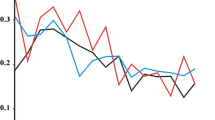We studied modifications of EEG activity related to perception of visual stimuli (pictures) of the International Affective Picture System (IAPS) in women during different phases of the ovulatory (menstrual) cycle. We found that the woman’s brain is most intensely activated by both emotionally negative and positive visual stimuli during the follicular phase of the ovulatory cycle, while such activation is minimum during ovulation per se. Upon the action of neutral stimuli, cerebral activation was the most intense during the lutein phase (compared with that within other phases); manifestations of activation were concentrated in the right hemisphere. Cognitive and emotional components of perception of affective pictures were expressed to a greatest extent in the course of viewing positive stimuli during the follicular phase. Perception of emotionally pleasant stimuli during other phases was accompanied by lateralization of activation of sensory and analytical processes in the left hemisphere during the ovulatory phase and in the right hemisphere within the lutein phase. The viewing of emotionally negative pictures during the follicular phase led to a rise in the power of theta oscillations in the left frontal region and also to depression of the alpha activity in central/parietal parts of the left hemisphere, which can result from aggravation of anxiety and verbally shaped disturbing ideas upon the action of such stimuli. Presentation of erotically colored visual stimuli caused the most intense changes in the EEG, which depended on the phases of the ovulatory cycle, during post-stimulation time interval but not during the viewing of pictures itself.
Similar content being viewed by others
References
J. M. Goldstein, M. Jerram, R. Poldrack, et al., “Hormonal cycle modulates arousal circuitry in women using functional magnetic resonance imaging,” J. Neurosci., 25, No. 40, 9309–9316 (2005).
J. C. Dreher, P. J. Schmidt, P. Kohn, et al., “Menstrual cycle phase modulates reward-related neural function in women,” Proc. Natl. Acad. Sci. USA, 104, No. 7, 2465-2470 (2007).
B. B. Sherwin, “Estrogen and cognitive functioning in women,” Endocrine Rev., 24, No. 2, 133–151 (2003).
J. A. Schmitt, B. L. Jorissen, L. Dye, et al., “Memory function in women with premenstrual complaints and the effect of serotonergic stimulation by acute administration of an alpha-lactalbumin protein,” J. Psychopharmacol., 19, No. 4, 375–384 (2005).
G. van Wingen, F. van Broekhoven, R. J. Verkes, et al., “How progesterone impairs memory for biologically salient stimuli in healthy young women,” J. Neurosci., 27, No. 42, 11416–11423 (2007).
M. J. Weiser, C. D. Foradori, and R. J. Handa, “Estrogen receptor beta in the brain: from form to function,” Brain Res. Rev., 57, No. 2, 309–320 (2008).
K. M. Heilman, “The neurobiology of emotional experience,” J. Neuropsychiat. Clin. Neurosci., 9, No. 3, 439–448 (1997).
X. Zhu, X. Wang, C. Parkinson, et al., “Brain activation evoked by erotic films varies with different menstrual phases: An fMRI study,” Behav. Brain Res., 206, No. 2, 279–285 (2010).
P. J. Lang, M. M. Bradley, and B. N. Cuthbert, International Affective Picture System (IAPS): Affective Ratings of Pictures and Instruction Manual, NIMH Center for the Study of Emotion & Attention, Univ. of Florida, Gainesville (2005).
S. Solís-Ortiz, J. Ramos, C. Arce, et al., “EEG oscillations during menstrual cycle,” Int. J. Neurosci., 76, Nos. 3/4, 279–292 (1994).
E. Niedermeyer and F. L. da Silva, Electroencephalography, Williams & Wilkins, Lippincott (2005).
H. Laufs, J. L. Holt, R. Elfont, et al., “Where the BOLD signal goes when alpha EEG leaves,” Neuroimage, 31, No. 4, 1408–1418 (2006).
P. Chua, M. Krams, I. Toni, et al., “A functional anatomy of anticipatory anxiety,” Neuroimage, 9, No. 6, 563–571 (1999).
L. I. Aftanas, S. V. Pavlov, N. V. Rayeva, and A. A. Varlamov, “Analysis of evoked synchronization and desynchronization of EEG under conditions of perception of threatening and positive emotional information: effect of the factor of the personality anxiety,” Zh. Vyssh. Nerv. Deyat., 54, No. 4, 473–481 (2004).
C. L. Bethea, M. Pecins-Thompson, W. E. Schutzer, et al., “Ovarian steroids and serotonin neural function,” Mol. Neurobiol., 18, No. 2, 87–123 (1998).
P. J. Morgane, J. R. Galler, and D. J. Mokler, “A review of systems and networks of the limbic forebrain/limbic midbrain,” Prog. Neurobiol., 75, No. 2, 143–160 (2005).
K. N. Ochsner, S. A. Bunge, J. J. Gross, and J. D. Gabrieli, “Rethinking feelings: An fMRI study of the cognitive regulation of emotion,” J. Cogn. Neurosci., 14, No. 8, 1215–1229 (2002).
S. Stoléru, M. C. Grégoire, D. Gérard, et al., “Neuroanatomical correlates of visually evoked sexual arousal in human males,” Arch. Sex. Behav., 28, No. 1, 1–21 (1999).
J. J. Tarín and V. Gómez-Piquer, “Do women have a hidden heat period?” Human Reprod., 17, No. 9, 2243–2248 (2002).
R. Krug, W. Plihal, H. L. Fehm, and J. Born, “Selective influence of the menstrual cycle on perception of stimuli with reproductive significance: an event-related potential study,” Psychophysiology, 37, No. 1, 111–122 (2000).
P. S. Foster and D. W. Harrison, “The relationship between magnitude of cerebral activation and intensity of emotional arousal,” Int. J. Neurosci., 112, No. 12, 1463-1477 (2002).
C. Kirschbaum, B. M. Kudielka, J. Gaab, et al., “Impact of gender, menstrual cycle phase, and oral contraceptives on the activity of the hypothalamus-pituitary-adrenal axis,” Psychosom. Med., 61, 154–162 (1999).
Author information
Authors and Affiliations
Corresponding author
Additional information
Neirofiziologiya/Neurophysiology, Vol. 42, No. 5, pp. 433–441, September-October, 2010.
Rights and permissions
About this article
Cite this article
Makarchouk, N.E., Maksimovich, K.Y., Kravchenko, V.I. et al. Modifications of EEG Activity Related to Perception of Emotionally Colored, Erotic, and Neutral Pictures in Women during Different Phases of the Ovulatory (Menstrual) Cycle. Neurophysiology 42, 362–370 (2011). https://doi.org/10.1007/s11062-011-9170-z
Received:
Published:
Issue Date:
DOI: https://doi.org/10.1007/s11062-011-9170-z



